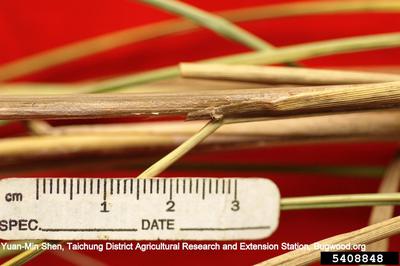Stalk Rot of Maize
Gibberella fujikuroi
Fungus
In a Nutshell
- Weak stalks.
- Small, black fungal structures on stalks.
- Discoloration of ear.
- Stunted growth.
Can also be found in
Symptoms
Symptoms may vary depending on environmental condition and the severity of the disease. Infected plants are easily detected for their abnormal height, either elongated or stunted and pale appearance. Seeds show lesions, rot and distortion. Stems show discoloration of bark, mouldy growth, stunting or rosetting. Leaves show abnormal colors and fungal growth. The heads are affected by black or brown lesions, scabs and ear rot. The whole plant damps off and there is early senescence and seedling blight.
Recommendations

Organic Control
To control the insects that transmit the pathogen spray neem extracts. Introduce bio control agents such as Trichoderma spp. to suppress the pathogen. Pseudomonas fleurosense is also effective in controlling Stalk Rot. Both of those ingredients can be used as a seed treatment as well as a soil application. Fortify with 250 kg FYM.

Chemical Control
Always consider an integrated approach with preventive measures together with biological treatments if available. Treat your seeds with a solution of mancozeb 50% and carbendazim 25% before planting them.
What caused it?
The disease is caused by the soil borne fungus Gibberella fujikuroi. The pathogen spores are dispersed by wind and rain and enter the maize ears through wounds. Plants are affected from seed germination on towards tassle emergence but symptoms are visible at later stages. It survives on seeds, crop residues or on alternative hosts such as grasses. It Spreads via spore infection through silks, roots and stalks. It enters the corn ears primarily through wounds from feeding damage from insects. It germinates and gradually colonizes the kernels from the entry points. Alternatively, it can start to colonize the plant from the roots and move up the plant through systemic growth. Plants can get infected under a wide range of environmental (stress) conditions, but the symptoms become particularly severe when the weather is warm (26-28°C) and moist and the plants have reached the flowering stage.
Preventive Measures
- Plant disease free seeds and tolerant varieties such as SC 637.
- Ensure healthy and strong stalk development by minimizing overall stress in maize plants.
- Limit plant populations to 28,000 to 32,000 plants per acre in fields with known history of stalk rot with 70-90 cm inter-row spacing and 30-50 cm between plants.
- Practice careful irrigation, weed control and mantain adequate soil nutrient levels.
- Monitor plants carefully and watch out for white streaks in the grain surface, yellowing of young leaves and wilting symptoms at flowering stage and reddish browning of infected stalk at advanced stage.
- Keep stalkborers at a low level as they disperse the pathogen.
- Ensure good fertilization during later stages of plant growth.
- Remove infected plants and bury them.
- Till the soil to bury infected crop debris.
- Clean storage facilities thoroughly.
- Before stroring the grainheat the kernels until the moisture content is at or below 15%.
- Store grains at low humidities and low temperatures.
- Plan crop rotation after three years with legumes e.g.
- beans or soybean.



